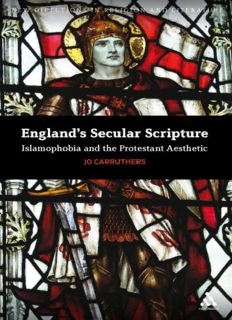
England's Secular Scripture: Islamophobia and the Protestant Aesthetic PDF
Preview England's Secular Scripture: Islamophobia and the Protestant Aesthetic
ENGLAND’S SECULAR SCRIPTURE New Directions in Religion and Literature Series Editors: Mark Knight, Roehampton University and Emma Mason, University of Warwick This series aims to showcase new work at the forefront of religion and literature through short studies written by leading and rising scholars in the field. Books will pursue a variety of theoretical approaches as they engage with writing from different religious and literary traditions. Collectively, the series will offer a timely critical intervention to the interdisciplinary crossover between religion and literature, speaking to wider contemporary interests and mapping out new directions for the field in the early twenty-first century. Titles in the series include: Blake. Wordsworth. Religion. Jonathan Roberts Do the Gods Wear Capes? Spirituality, Fantasy, and Superheroes Ben Saunders The New Atheist Novel: Fiction, Philosophy and Polemic after 9/11 Arthur Bradley and Andrew Tate ENGLAND’S SECULAR SCRIPTURE ISLAMOPHOBIA AND THE PROTESTANT AESTHETIC JO CARRUTHERS NEW DIRECTIONS IN RELIGION AND LITERATURE Continuum International Publishing Group The Tower Building, 11 York Road, London SE1 7NX 80 Maiden Lane, Suite 704, New York, NY 10038 www.continuumbooks.com © Jo Carruthers 2011 All rights reserved. No part of this publication may be reproduced or transmitted in any form or by any means, electronic or mechanical, including photocopying, recording, or any information storage or retrieval system, without prior permission in writing from the publishers. Jo Carruthers has asserted her right under the Copyright, Designs and Patents Act, 1988, to be identified as Author of this work. Act, 1988, to be identified as Author of this work. British Library Cataloguing-in-Publication Data A catalogue record for this book is available from the British Library. ISBN: 978-0-82643937-6 Library of Congress Cataloging-in-Publication Data A catalog record for this book is available from the Library of Congress CONTENTS Acknowledgements Series Editors’ Preface Introduction Chapter One The English Reformation and the Protestant Aesthetic Chapter Two Secularizing the Protestant Aesthetic Chapter Three Contemporary Englishness and the Protestant Aesthetic Chapter Four The Protestant Aesthetic and Islamophobia Notes Bibliography Index ACKNOWLEDGEMENTS Thanks must first go to the Series Editors Mark Knight and Emma Mason who first thought that a book on Englishness and Protestantism was a good idea, and without whom it may never have been written. Unremittingly supportive, they have undoubtedly enriched this book by commenting on its early drafts. I am indebted to the Research Councils UK, who funded my Research Fellowship. I am also grateful to David Avital and Colleen Coalter at Continuum for bringing it to publication. This book has been brewing for a long time and there are many people to thank for contributing towards it and for helping me refine my ideas. It is in conversations with Naomi Baker, alongside whom I first taught early modern literature at Manchester University, that the kernel of this book first started to take shape. I owe to her and my fellow postgraduates – especially Deirdre Boleyn, Rachael Gilmour and Zoë Kinsley – a debt of gratitude for support and friendship. My thoughts about Englishness were also helped along by the undergraduates at Lancaster University who took my course on ‘England and Englishness’. They brought the many texts we studied to life and made me think more deeply about emotional attachment to nation. I have been extremely fortunate in my places of work and I thank my current colleagues at the University of Bristol in both the English and Theology departments, and those involved in the Place and Space theme, all of whom provide a collegial and stimulating research context. My profound thanks go to all those who have generously commented on drafts: Naomi Baker, Sally Bushell, Ranji Devadason, Nasar Meer, Angela Piccini, Tom Sperlinger and Ika Willis. Many of my ideas have been formed over conversations with friends and colleagues, especially: Jeanette Brejning, Daniel Pablo Garay, Vivienne Jackson, Jon Roberts, Helen Smith, Catherine Spooner, Andrew Tate. I owe an especial debt of gratitude to those colleagues who have been unremittingly encouraging and wise: to Gavin D’Costa and Carolyn Muessig for being amazing, and to Angela, Ika, Ranji and Tom for friendship and collaborations. My profound gratitude goes to my family. To my mum and John, thank you for moving to Skye and providing me with such a congenial working place! To Sue and Jeff for all your encouragement. To Richard, who has patiently supported the long hours that have gone into this book, thank you for your love, belief and practical support. And to Molly, whose support has been markedly less practical but who made my breaks more frequent and more fun. SERIES EDITORS’ PREFACE This series of short monographs seeks to develop the long-established relationship between the disciplines of religion and literature. We posit that the two fields have always been intimately related, aesthetically, formally and theoretically, creating a reciprocal critical awareness framed by the relatively recent theo-literary thinking of figures such as Walter Benjamin, Martin Buber, Hans-Georg Gadamer and Geoffrey Hartman. Committed to reflecting on the question of how these two disciplines continue to interact, we are particularly concerned to redress the marked evasion of this relationship within existing scholarship. As Stanley Fish recently declared, religion has the capacity to ‘succeed high theory and race, gender and class as the centre of intellectual energy in academe’. The books in this series are written by a group of critics eager to contribute to and read work intimate with both evolving and new religious and literary debates. Pursuing a variety of theoretical approaches to an array of literary and cultural texts, each study showcases new work on religion and literature while also speaking to wider contemporary concerns with politics, art and philosophy. In doing so, the books collectively map out new directions for the field in the early twenty-first century. Mark Knight Emma Mason
